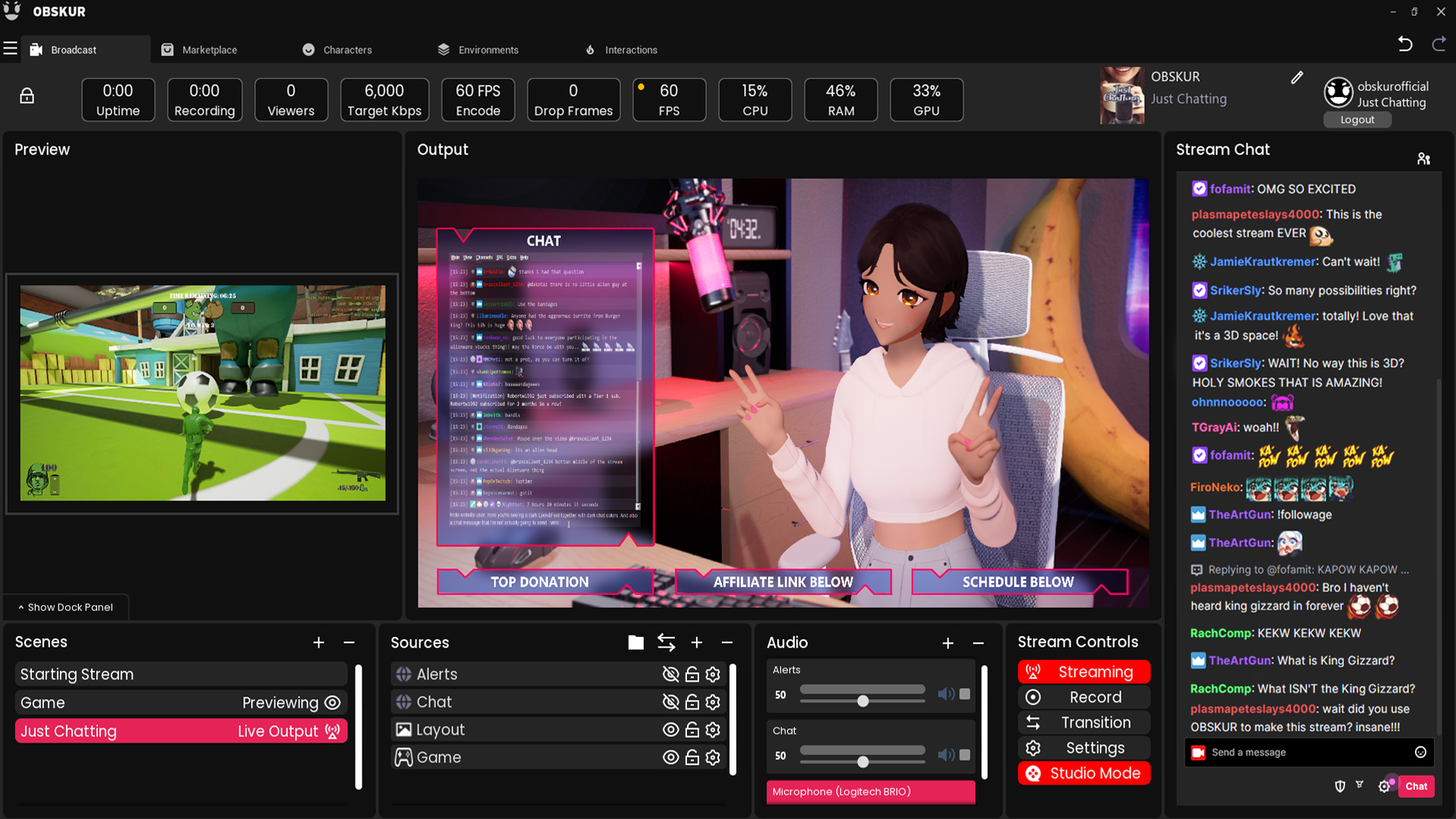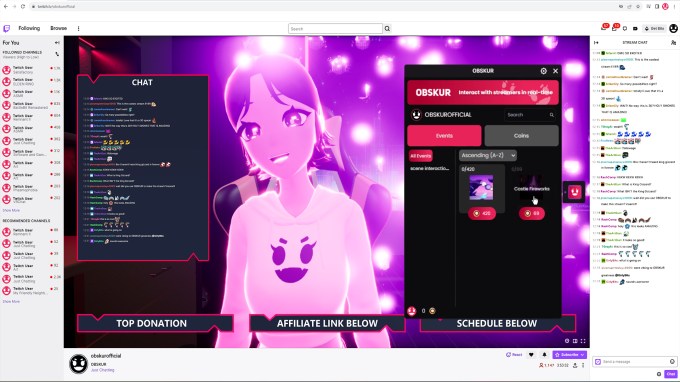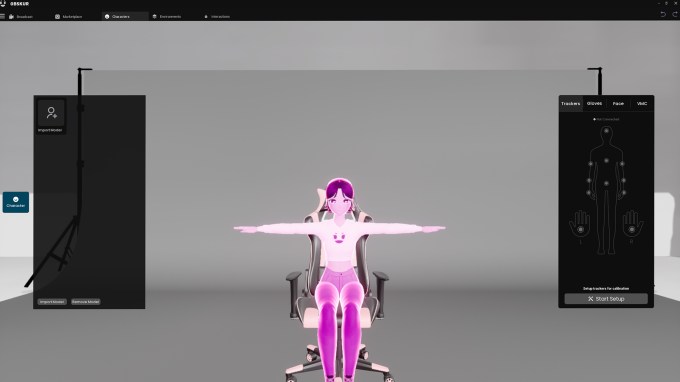To stream as their ethereal alter ego, Mai, a VTuber known as M41H41, typically had to juggle at least four to seven different programs. Running all of them at once, however, was both mentally exhausting and a burden on their computer, which could overheat mid-stream. If a program crashed, they’d have to break character to fix it.
“Oftentimes, I actually would have to not use every single program,” Mai told TechCrunch during a Discord call. “So I literally had to tell my community, ‘Sorry, we’re not going to be able to have like, throw videos or chat interactive videos today, because I literally can’t run it right now.’”
I'm stremmin!! Come hang out and chill mumumu! pic.twitter.com/t7ALcHaDof
— M41 (MAI) VA + Y2K Roomba? VTuber On Hiatus (@M41H41) October 28, 2023
VTubers — a portmanteau of “virtual YouTuber” — stream as a 2D or 3D model, rather than reveal their actual faces. The burgeoning genre has produced wildly successful streamers, but has involved a high barrier of entry because of the startup costs and technical skills involved in streaming as an animated character.
Obskur, an all-in-one broadcasting application, wants to make VTubing more accessible by letting users create 3D models and interactive environments without technical skills. The company debuted several new features at TwitchCon, including Character Creator, which officially launched last week. Obskur’s broadcasting software essentially rolls multiple different programs into one platform that’s easily integrated with Twitch — a massive draw for VTubers like Mai.
Obskur’s Character Creator and user-generated content marketplace especially unique in the VTubing space. The Character Creator lets users customize 3D models by picking from a selection of free hairstyles, facial features and body types. Users can adjust the features with sliders to change shape and size, and select feature colors from a color wheel. For further customization, users can peruse the integrated marketplace, where artists sell premade models and 3D assets like outfits and interactive backgrounds.
“It needs to be advanced enough that people can make characters that are unique enough that they can feel like, ‘This is me and my brand.’ But it also has to be easy enough where you don’t need to know anything,” Obskur co-founder Andranik Aslanyan told TechCrunch. “Like you don’t need to understand rigging or modeling or textures or anything. You just pick some options and it feels like a video game. If you can play The Sims you should be able to use our application.”

Mai said they began regularly using Obksur after testing a demo at TwitchCon. Before then, they used up to a dozen applications to run their streams.
There’s one to run their model, who often sports flowing seafoam colored hair, pink moth-like antennae and a black top with a ruffled collar, and another for improved body tracking. Running basic animations required another software; something as simple as a VTuber making their model cry, for example, or bounce their breasts to flirt with subscribers, can involve technical finesse that viewers rarely see behind the scenes. Mai had to use a third program for any chat interactions, like allowing their viewers to throw objects at them or sprinkle them with flower petals, and an additional third-party software to integrate those interactions with Twitch’s monetization features. They also needed a program to upload their model into a 3D background, which could range from a basic living room to an extraterrestrial planet.
“And that’s before you even think about the kind of content you’re making that day,” Mai continued. “And you have to learn how every single one of those not only works as an application by itself, but also how it works as an application with the others you’re running. I probably had between 10 and 12 applications that I had downloaded just for different parts of my model.”
Then there’s the cost. When Mai first got into VTubing last year, they tried to make their own model using the free software VRoid Studio, drawing with a mouse. It was impossible, they said, and “it looked all kinds of terrible.” They ended up paying another artist around $100 to 120 (the “absolute lowest end” in the industry) for a model. High-quality 2D models can cost upwards of thousands of dollars, depending on the quality of the original artwork, custom meshes and textures and various animations. Even 3D models, which are less complicated to animate, are still pricey to commission. Supplementary assets, like new outfits, hairstyles and backgrounds, cost more and are a challenge to source. While many artists focus on custom commissions, others sell preset assets on Etsy, Patreon or other online marketplaces scattered across the internet. Some bigger marketplaces, such as Booth, are a “whole monster in and of itself,” Mai said, because they’re entirely in Japanese.
“Then you have to download these, hoping that they’re in the right file format, because if you don’t speak the language, who knows?” Mai said.
Aslanyan noted that chat interactions weren’t only a headache to use, but also visually clunky. On Twitch, users can purchase Bits, which start at $3.00 for 300 and are priced up to $308 for 25,000. Twitch pays streamers 1 cent per Bit, so streamers typically offer special perks to viewers who spend Bits during their streams. VTubers often entice viewers to spend Bits by offering certain interactive features. Viewers can “throw” objects like digital money at VTubers by spending 100 Bits, for example, or change their outfit by spending 1,000 Bits. Streamers had to manually trigger the interactions on whatever third-party software they were using, while staying in character and engaging with their viewers.

Obskur’s Twitch extension and app makes features like audience interaction more seamless for both streamers and viewers. In the app, streamers can determine various tiers of interactions, which will be automatically triggered when viewers spend Bits. Obskur takes a standard 20% developer cut, which was set by Twitch. Aslanyan hopes that by making the process more seamless, monetization opportunities will be more accessible for streamers.
“The idea behind that is giving a reason for your audience to spend a bit, because when you look at Bit revenue compared to things like subscriptions or direct donations, it’s on the lower end,” Aslanyan said. “The reasoning is just there’s no real incentive for Bit donations.”
It may be easier for streamers to monetize their work, but are artists at risk of losing commissions? 2D and 3D design for VTubers grew into a digital cottage industry since 2020, and many artists rely on commissions for their full-time income. Neither Mai nor Aslanyan are concerned about Obskur’s Character Creator pushing out artists. Instead, they said that the platform’s user-generated marketplace creates opportunities for artists to expand their clientele. Mai described the Character Creator as a “baseline” opportunity for absolute beginners to step into VTubing without breaking the bank or learning complex animation.
“I do think there’s still a lot of desire for specific art styles for specific designs that are only unique to individual artists, who are still performing the craft on other mediums, and I think there are going to be plenty of artists who move over to primarily working in Obskur because the marketplace allows you to make money off your assets that you already created,” Mai said.
And if streamers do want to use a more complex, highly specific model for their streams, they can import commissioned work into Obskur.


Aslanyan added Obskur took artist feedback into account when designing the Character Creator. Obskur’s art director, an artist known as TheArtGun, is known for designing models for Ironmouse, who is one of the most popular VTubers in North America. She oversaw the development of the Character Creator, and was involved in the launch of the marketplace, Aslanyan said.
“The way that I would look at it from the creator perspective is increasing the market size,” Aslanyan continued. “It’s a one-to-one basis. In our case, you might be able to produce a cool jacket, and then in the market, now that people can access characters pretty much instantaneously, you can sell the jacket many times over, and potentially produce more revenue than spending three months producing a character for one person. It’s more of a scale business than it is an individual kind of commission business.”
Mai is excited that tech companies are finally paying attention to the VTuber industry. They said that the market is “underutilized” and is in desperate need of innovation, like applications that streamline multiple programs into one. In the few weeks since they started using Obskur full-time, they’ve seen a significant improvement in their streams.
“I don’t have to worry about opening 15 million programs anymore,” Mai said. “I used to have to worry about opening programs, making sure they were all running smoothly, that everything was playing nice with each other. But now I just start it up and bam! It’s already all good.”
TwitchCon 2023 was better than last year, but everyone hated Las Vegas






























Comment